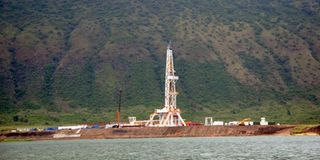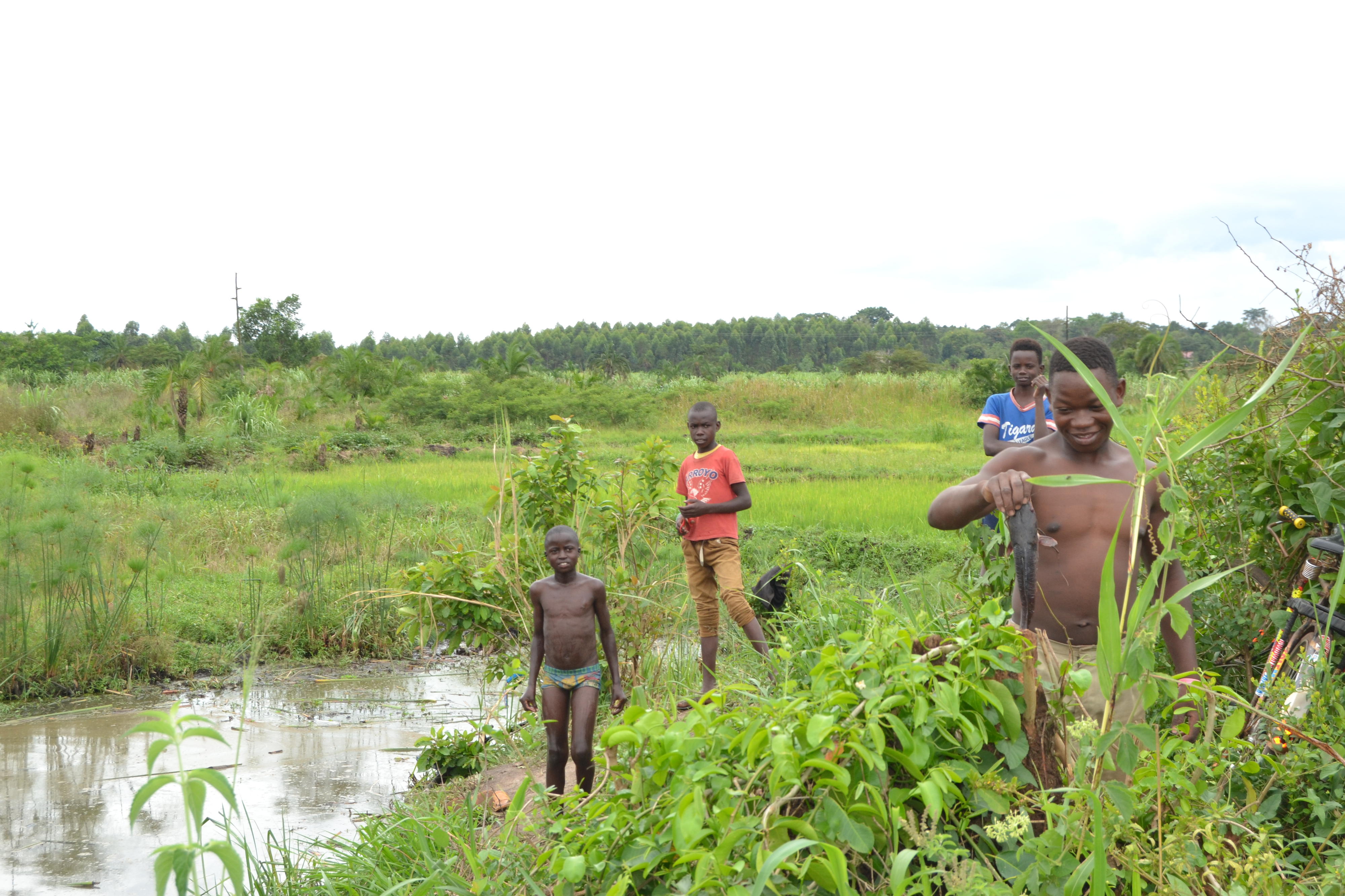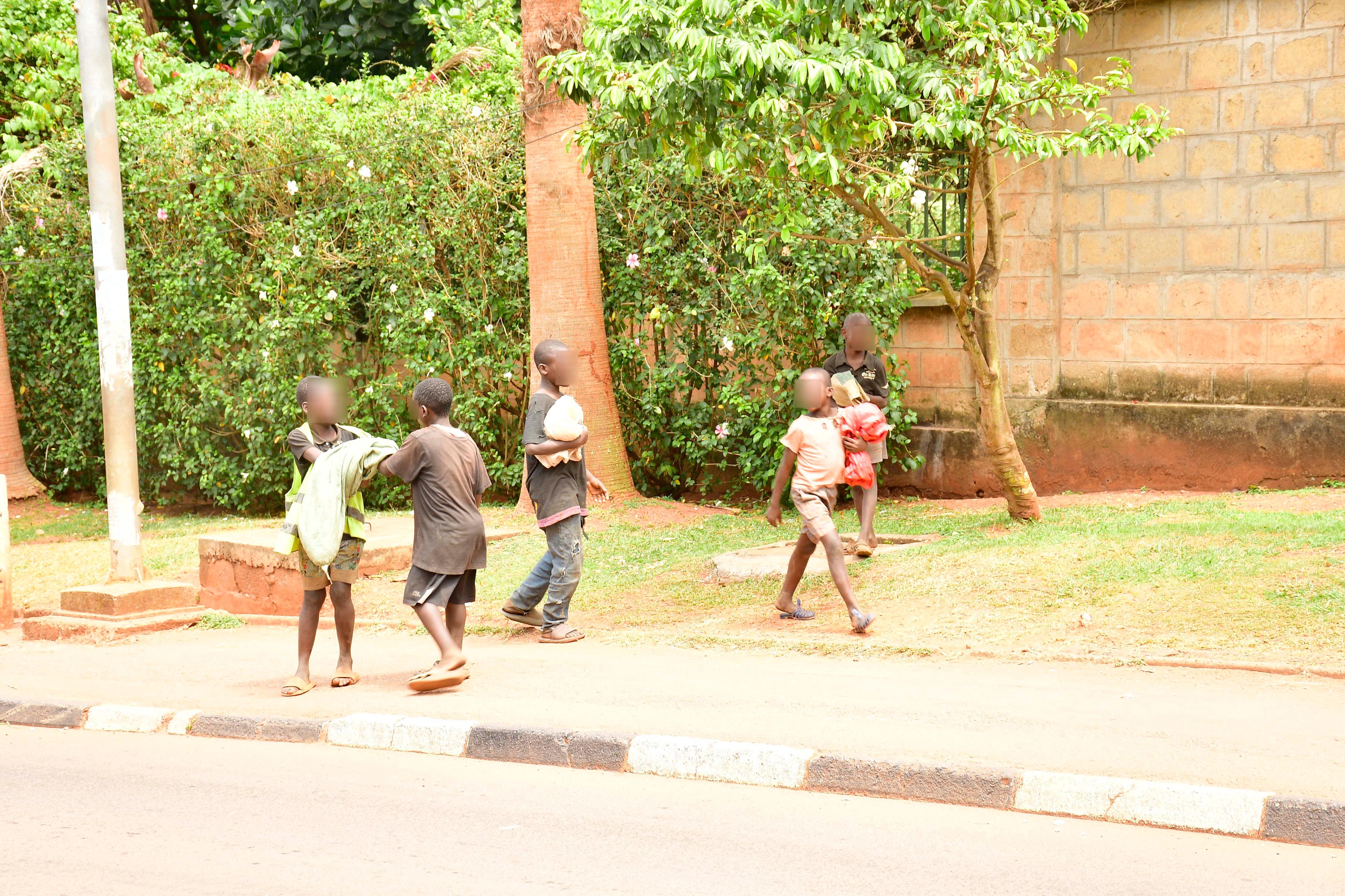Prime
Oil sector: Bad prices, job cuts and little activity

An oil rig on the shores of Lake Albert in Buliisa District. While there was little activity on one side, on the other side, government kick-started the much-awaited licencing round for six new oil blocks in the Albertine Graben, including Taitai and Karuka block in Buliisa District. File photo.
What you need to know:
Oil dreams. The oil bonanza in Uganda sparked off all sorts of hopes and expectations, jobs, development, liquid-like flowing cash in form of handouts, among others. Not everything has gone as planned, at least so far, writes Frederic Musisi.
The oil industry, with its history of highs and lows, had a rather very terrifying 2015 with tumbling prices for crude oil.
Not just oil-producing countries saw their economies ground to halt or small/average oil companies struggling to keep their heads above troubled waters, but the world’s super major/biggest oil companies felt the pinch too.
Patrick Pouyanne, the chief executive officer of the French oil giant, Total, the parent company to Total E&P, one of the three International Oil Companies (IOCs) licensed to operate in Uganda, in September last year told an investors’ conference in London that the company was eying slashing capital spending further this year hinged on the slump in trading prices for crude.
Investments in oil and gas projects, Pouyanne, who was in Uganda late last year during the Christmas week to meet President Museveni, indicated will be condensed to $20 billion-$21 billion from the $23 billion-$24 billion the company spent last year.
The price of a barrel for Brent oil (the main international benchmark for crude), which was more than $100 (about Shs335,000) earlier 2014, staggered from $90 to $36 at the end of 2015. It has since gone further to $31 per barrel.
Some commentators are predicting it will even fall further to $20, while the optimistic ones occasionally forecast prices picking up - but the situation keeps deteriorating.
Low prices; sunset or sunrise for Uganda?
Notwithstanding the shocks in the global oil market, Pouyanne, according to a statement issued by Total E&P Uganda, indicated the company was committed to commencing production “as soon as possible, whatever the oil price is because Uganda’s oil resources are potentially low-cost resources, which will be competitive in the market.”
Currently, the stock tank oil in place/reserves stand at 6.5 billion barrels, but there is early indication they could soon hit eight billion barrel. The recoverable rate though is still lower at 1.4 billion barrels, up from the earlier 1.2 billion barrels even when total reserves increased by three billion barrels in 2014.
Only 40 per cent of the 23,000 Sqkms Albertine size has been appraised so far.
The current fall in prices is the first major shock to happen, recently, since commercial oil volumes were announced in 2006, when the price of a barrel had barely touched $100. By the time Uganda starts to send its crude oil to the market, who knows, the price could have gone back up.
Never mind also that the official contents of the cost/revenue sharing in the Production Sharing Agreements (PSAs) are still clouded in a fog, whatever the price of crude is or will be.
The pipeline deal
Pouyanne’s visit also shed light on another important milestone that has remained a thorn in the foot for Uganda and her two neighbours to the East and down South—the crude export pipeline. In the meeting with President Museveni at the Jinja State Lodge, which was also attended by the permanent secretary in the Ministry of Energy Kaliisa Kabagambe, executive director of the Petroleum Directorate Ernest Rubondo and Energy minister Irene Muloni, the pipeline route was at the core.
According to both official and insider accounts, the final position on the route will be announced later.
The three IOCs, which operate as a Joint Venture Partnership, Total, UK’s Tullow Oil PLC and China’s Cnooc, in 2014 signed a Memorandum of Understanding (MoU), which details a commercialisation plan for Uganda’s oil. This included development of the oil fields, a crude export pipeline and a mid-size refinery.
Later in 2014, a Japanese engineering firm, Toyota Tsusho, was brought on board to conduct a feasibility study on the least cost routes for the proposed pipeline. The two routes include one from Uganda’s Albertine Graben through Lake Kyoga via North East Uganda, then connect to Kenya’s Lokichar basin, where oil discovery is ongoing, to Lamu. The other via Lake Victoria through Tanzania to the Tanga port.
Toyota firm was undertaking development of a separate pipeline from South Sudan to Kenya’s Lamu port at the Indian Ocean coast. In the final report, Toyota recommended the Kenyan route as the “least cost” route.
The estimated cost of the pipeline infrastructure is $4.5b (about Sh17t).
In August last year, President Museveni and his Kenya counterpart Uhuru Kenyatta signed a MoU to seal the deal on the Lamu route. However, barely an hour later after the announcement had been made at a ceremony at State House, the technocrats who had tagged along with President Kenyatta expressed discomfort at some of the conditions that Uganda had set.
Some of the conditions Kenya contested included guaranteeing upfront financing the project and other supporting infrastructure needed, and guaranteeing transit fees/tariff not higher than any of the alternative routes before discussion with the technical team back at home.
As the Kenyan team went back to consult, Total also kicked up the storm by opposing a pipeline to Northern Kenya, citing security concerns there. Much as Uganda seemed in favour of the Lamu route, which connects to the LAPSETT corridor (an infrastructural mix by the governments of South Sudan, Kenya, and Ethiopia), Total with its financial muscle stood ground, and immediately the Ugandan technocrats started-off discussions with their Tanzanian technocrats.
In October last year, the Energy ministry permanent secretary Kaliisa and his Tanzanian counterpart Ngosi Mwihava signed another MoU that paved way for the pipeline to snake through Tanzania.
“If we get the least cost pipeline to Tanga, then our crude oil will be exported cheaply. We need to carry out due diligence, which requires technical work, to inform our citizens about the end-user tariffs and the memorandum of understanding sets the stage for carrying out detailed evaluation,” Kaliisa said.
Notwithstanding security concerns, insiders indicated the IOCs, Tullow in Uganda because of its operations in Kenya was and is in favour of the Lamu route, while Total is in favour of the Tanzania route where the company has interests in the country’s vast gas reserves. Discussions between Uganda and her neighbours on the two routes are still ongoing and may fold later in the year.
Unfinished birth of Uganda’s oil refinery
The MoU signed in 2014, also paved way for a refinery. Earlier in 2010, government had hired Foster-Wheeler, a Swiss engineering firm, to study the viability of the Shs15 trillion ($4b) infrastructure. The Foster-Wheeler report posited the refinery as a worthwhile adventure much as the IOCs and petroleum economists expressed reservations.
The government immediately went to work, hiring US-based firm Taylor Dejong to offer technical advice on picking an investor for the refinery.
Request for Qualification documents were put out and several firms, big and small, applied and went through various stages of vetting.
Only four firms made it to the last round—Russia’s RT Global Resources, Japan’s Maruben Corporation, China’s Petroleum Pipeline Bureau (CPPB), and South Korea’s SK Engineering and Construction Co. Ltd.
President Museveni had in earlier months scolded Western countries for what he called their “arrogance” and said China and Russia were available as alternatives because they do not meddle in internal politics of other countries.
While many observers thought a Chinese firm would take the deal, it still remained no surprise when the refinery deal went to the East.
Insiders intimated that CPPB was knocked out over what was believed to be political connections to former Prime Minister Amama Mbabazi, whose relationship with the powers that be had collapsed.
Early this year, government announced that RT Global Resources is the preferred bidder to develop the Greenfield refinery. SK was retained as plan B.
RT is a subsidiary of Rostec, a defence and technology corporation whose businesses include manufacturers of weapons such as the AK-47 (Kalashnikov rifles). The company was picked fresh on the heels of sanctions by the US and European Union slapped on Sergei Chemezov, Rostec’s chief executive, a former officer in the Russian spy agency-KGB- and close ally of President Vladimir Putin—for Russia’s annexation of Ukraine.
Others members in the RT consortium include VTB, Capital Plc, a subsidiary of VTB, the second largest Russian state-owned bank, Telconet Capital Ltd Partnership, Tatneft JSC and GS Engineering Construction Corporation (South Korea).
The refinery will be developed in phases, starting with 30,000 barrels per day (bpd), while another phase of 30,000bpd is expected to be added by 2022/2024 according to government. The infrastructure will be developed along with product storage sites, as well as the construction of a 305 kilometre product pipeline to a terminal in Buloba, Wakiso District.
The government and RT immediately started negotiations but as 2015 drew closer, an end was not in sight. Much as technocrats in government told the country negotiations would be closed by December, RT’s East Africa regional representative Andrey Kozenyashev told this newspaper sometime in September last year that while they were likely to sign up the deal, closing the Final Investment Decision (FID) could take another 18 months.
Before signing FID means the company cannot start work. Kozenyashev said this bidding of time would allow them undertake more feasibility studies on the project, study the quality of crude oil and also beat the thick bureaucracy on tax exemptions, secure permits, this and that.
The refinery will be financed/ owned in Public Private Partnership (PPP) arrangement with government in a 60:40 equity ratio. However, other East African countries are set to buy stakes in the project to facilitate its financing. Only Kenya has so far expressed interest in buying a stake.
Some technocrats intimated that a major announcement between government and RT was underway in the new year, specifically in the first weeks of this month.
The government in the same regard also hired Ramboll Group A/S, a consulting engineering company from Denmark to conduct “an early phase” detailed route and environmental study for finished product (oil pipeline) that will run from the Albertine Graben - Hoima to Buloba in Wakiso. The 210 km pipeline is part of the refinery project.
Next licensing round
While there was little activity on one side, on the other side, government kick-started the much-awaited licensing round for six new oil blocks in the Albertine Graben. The blocks are Semiliki and Kanywataba blocks in Ntoroko District, Ngassa block in Hoima District, Taitai and Karuka block in Buliisa District, Mvule block in Yumbe and Moyo districts and Ngaji block in Kanungu and Rukungiri districts.
The Petroleum Directorate, formerly the Petroleum Exploration and Production Department (PEPD), said it had received applications from 17 prospective international oil companies to vie for the fields. The companies, however, were mostly the small or average sized-oil companies, not the bigger world players. Vetting of the companies is ongoing.
Job cuts, slow business for contractors
Higher institutions of learning have been promoting oil and gas courses for graduates, one would say in the long-run.
However, 2015 started off with the three IOCs trimming and merging staff positions owing to the need to reduce operational costs hinged on the plummeting oil prices. Tullow kicked up the storm by laying off at least 120 employees. The company had started with slashing 41 positions in 2014.
Total followed suite, laying off 30 workers and more later.
The reasons the two firms gave was that the completion of the exploration phase means all drilling operations and related activities had been completed, therefore, as they prepare for the production phase, there is substantial reduction of operations and related activities.
Several local businesses involved with various contracts with the oil companies also started feeling the pinch with the limited activity in the sector. The Association of Uganda Oil and Gas Service Providers raised a red flag that they were facing tough times.
The trend is likely to drag on, perhaps until when production licences for Tullow and Total are approved to start embarking on field development. However, it could also prolong until when construction of the refinery/pipeline starts or 2018/2019 when the first phase of commercial production sets in, according to government.
But for production to start, overall investments required in the sector over the next three to five years range between $10b (about Shs33.5 trillion) and $25b (about Shs83.7 trillion) for development of a refinery, pipeline and development of oil fields. Other key infrastructures that require massive investments include central processing facilities (CPFs)—where oil is both stabilised before it becomes tradable crude, and distribution terminals in Wakiso District.
Other major Highlights
Oil authorities take effect. The government also incorporated the National Oil Company, which is mandated to manage the government’s commercial interests in the petroleum industry.
President Museveni similarly ordained the NOC’s board led by businessman Emmanuel Katongole. The President also inaugurated the board of the National Petroleum Authority (NPA). The body is charged with regulation, overseeing and monitoring the downstream arm of the petroleum industry. Its seven-member board team is led by Jane Mulemwa, a Makerere University don and deputy chairperson of the Education Service Commission.
Cnooc production. Cnooc, the only firm with a production license for the Kingfisher oil field (Block EA-3A.), also retendered the deal for the Front End Engineering & Design (FEED)—for Kingfisher. The FEED among others looks required infrastructure at an oil well layout of well pads, and analysis on central processing facilities, before production starts.
Cnooc had in 2013 almost tapped Australia’s Worley Parsons as preferred bidder for the FEED but the deal did not materialise. French firm, Technip, was said to be in the lead for the new tender.
Production licences. The debate on production licences is expected to be concluded this year. By the end of last year, Total had three applications for licences in while Tullow had five.
Government had said the companies would be issued licences in December but the year would up in futility even after constitution of the Petroleum Authority, which by law reserves the mandate to issue licences.
Tullow-URA tax dispute. The government also entered into negotiations with Tullow over a tax dispute that could have earned Uganda $473m (Shs1.6tr).
Government eventually settled for less $250m (Shs890bn) after years of tight-rope pulling at The International Centre for Settlement of Investment Disputes (ICSID).




